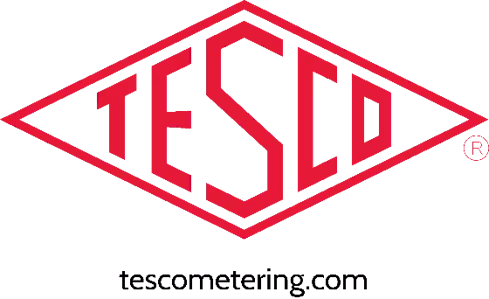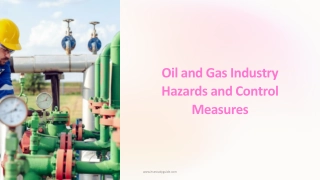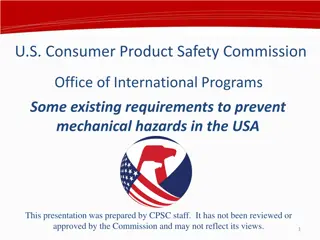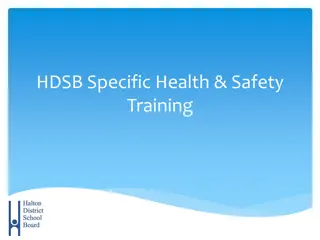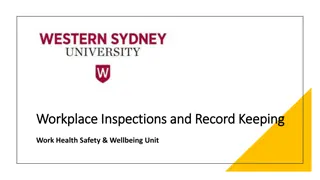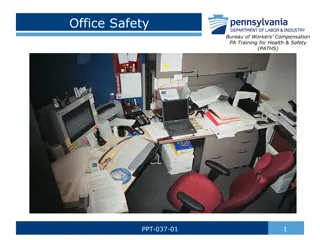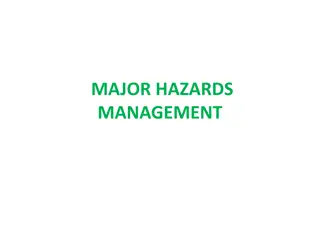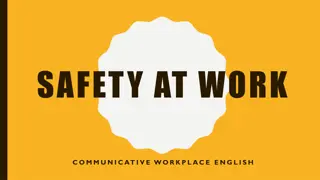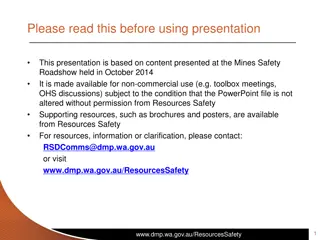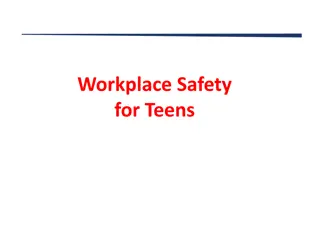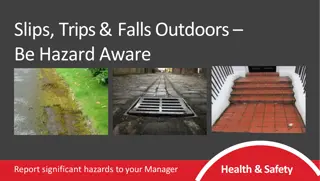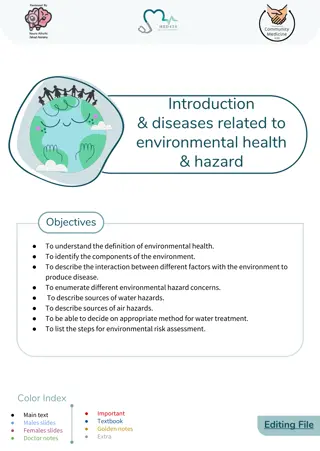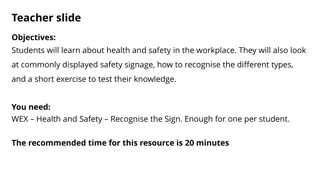Workplace Hazards and Safety Measures Awareness
Learn about common workplace hazards such as falls, chemical exposure, fire, electrical hazards, and repetitive motion injuries. Understand the risks associated with these hazards and the importance of prioritizing safety in the workplace to prevent accidents and injuries. Stay informed and take proactive measures to create a safe working environment for yourself and others.
Download Presentation

Please find below an Image/Link to download the presentation.
The content on the website is provided AS IS for your information and personal use only. It may not be sold, licensed, or shared on other websites without obtaining consent from the author.If you encounter any issues during the download, it is possible that the publisher has removed the file from their server.
You are allowed to download the files provided on this website for personal or commercial use, subject to the condition that they are used lawfully. All files are the property of their respective owners.
The content on the website is provided AS IS for your information and personal use only. It may not be sold, licensed, or shared on other websites without obtaining consent from the author.
E N D
Presentation Transcript
METER SAFETY Wednesday, July 12 11:00 AM-12:00 PM John Kretzschmar, SAMSCO 1
METER SAFETY YOU are responsible for your own safety on the job! 2 tescometering.com
HAZARDSINTHE WORKPLACE Hazard #1: Falls and Falling Objects Approximately 19,565 people die in the U.S. annually due to injuries caused by unintentional falls. Slips, trip and fall injuries cost employers approximately $40,000 per incident. About 9.2 million people were treated in emergency rooms for fall- related injuries last year. 3 tescometering.com
HAZARDSINTHE WORKPLACE Hazard #2: Chemical Exposure Breathing of contaminated air is the most common way that workplace chemicals enter the body. The CDC estimates more than 32 million workers in the US are potentially exposed to chemicals that can be absorbed through the skin. Roughly 860,000 illnesses resulting from chemical exposure occur in the workplace every year. 4 tescometering.com
HAZARDSINTHE WORKPLACE Hazard #3: Fire Hazards A structure fire is reported approximately every minute of every day and results in approximately $12 billion in property loss every year. According to the National Fire Protection Association, there were an estimated 3,340 fires in U.S. office properties per year. 5 tescometering.com
HAZARDSINTHE WORKPLACE Hazard #4: Electrical Hazards The construction industry accounts for 52% of all electrical fatalities in the US workplace. Most incidents and fatalities were caused by direct worker contact with overhead power lines and contact with machines, tools, and hand-carried metallic objects. Engineers, electricians, and overhead line workers top the list of professionals who are most exposed to electrical hazards. The most common type of work to result in an electrocution is routine work involving repair and maintenance. 6 tescometering.com
HAZARDSINTHE WORKPLACE Hazard #5: Repetitive Motion Injury According to the Bureau of Labor Statistics, Repetitive Motion Injury cases accounted for 33% of all worker injury and illness cases In the U.S., the costs associated with RMI s are estimated at $20 billion every year according to OSHA 7 tescometering.com
HOW DANGEROUSIS METERING? Electricity is Organized Lightning George Carlin Any Voltage without current will not kill you, but any voltage with current can kill you. 8 tescometering.com
ELECTRIC SHOCK What is Electric Shock? Electric shock is a flow of electrical current through a person's body. Damage to the skin or internal organs as a result of contact with electrical current is an electric injury. Electric shock can cause a minor twinge, mild to serious injuries, or death, depending on the circumstances and voltage. 9 tescometering.com
ELECTRIC SHOCK What is Electric Shock? The human body conducts electricity well, so it travels through the body with ease. People can incur organ damage even if there is only a minor burn on the skin. The most common areas injured by electric shock are the heart, muscles, and brain. 10 tescometering.com
ELECTRIC SHOCK Current Effect 1 mA Barely noticeable 16 mA Maximum current before you can t let go 20 mA Paralysis of respiratory muscles 100 mA Ventricular fibrillation starts 2 Amps Cardiac standstill and organ damage 11 tescometering.com
WORK INJURIES 12 tescometering.com
WORK INJURIES 13 tescometering.com
HEAT EXPOSURE 14 tescometering.com
ARC FAULT What is an Arc Fault? An Arc Fault is a type of electrical fault that that results from the breakdown of an insulating medium between two conductors where the energy is sufficient to sustain an arc across open air. 15 tescometering.com
ARC FLASH What is an Arc Flash? An Arc Flash in an event that occurs when electrical current flows through an air gap between conductors. An arc flash can cause extreme amounts of light and immense heat of more than 19,000o C. This can result in an explosive pressure wave called an arc blast. These forces combine to create a hazardous condition that can vaporize metal, destroy equipment, and pose a significant hazard to anyone in the vicinity. 16 tescometering.com
ARC FLASH Arc Flash can also be caused by: Common causes are the accidentally touching of a test probe to the wrong surface or a slipped tool. 17 tescometering.com
ARC FLASH Arc Flash can also be caused by: Sparks due to breaks or gaps in the insulation of the conductors. Equipment failure, improper insulation, substandard parts or substandard material. Magnetic fields created by dust, corrosion and other impurities can cause ionization of the surrounding air creating a path for a resulting flash. 18 tescometering.com
PERSONAL PROTECTION EQUIPMENT (PPE) This is why we wear our PPE. 19 tescometering.com
PERSONAL PROTECTION EQUIPMENT (PPE) Personal Protective Equipment Leathers Rubber Gloves Face Shield FR Clothing Safety Shoes Insulated Tools 20 tescometering.com
PERSONAL PROTECTION EQUIPMENT (PPE) Arc Flash PPE categories range from 1 to 4 Arc Flash PPE Category level 1 is the lowest risk level. Arc Flash PPE Category level 4 is the highest risk level 21 tescometering.com 21
HOW BAD CAN THINGS GET? Many thanks to Dominion Power https://youtu.be/2Xoyb9M5-EA Rubber Gloves and FR 4:10 Meter enclosure shorted out 10:48 Back feed from generator 19:34 22 tescometering.com
AS YOU APPROACHTHE SERVICE Moisture or water inside the meter face and/or rust on the meter base, such as leaks at the service entry cable or other meter base components. Missing knockouts on the meter base. Broken or cracked conduit at the electrical meter or meter hubs. Loose connections of the meter base, including meter pulling away from the building wall and loose mounting screws. Evidence of tampering at the meter, missing meter seal. We've seen house fires start when a screw from a loose meter box fell into the meter and caused a dead short. 23 tescometering.com
FIELD AUDITS/TROUBLESHOOTING/TESTING Always approach an electrical service with caution and while wearing your full PPE. Why? Never stand directly in front of the meter when removing the meter Before you even open the box or get the cover off . Live box Bees Other live animals Broken Seal Cover dropping off Uneven terrain 24 tescometering.com
FIELD AUDITS/TROUBLESHOOTING/TESTING 25 tescometering.com
FIELD AUDITS/TROUBLESHOOTING/TESTING 26 tescometering.com
ISSUESTO LOOK FOR ONCETHEBOXIS OPEN Open line side connection to the meter socket. Missing neutral connection to the center lug in the meter socket Cross wiring between the test block and the meter socket. Hidden jumper, line to load diversion on both legs. Dead short, phase to ground on the load side of one leg of the socket. Partial short, phase to ground on the load side of one leg of the socket. Evidence of burning or arcing at the meter base. 27 tescometering.com
TOOLS Socket Pullers Volt meters Insulated tools Specialized tools 28 tescometering.com
SUMMARY Be Careful Assume the box is live Assume there is something live in the box Treat electricity with respect Treat all meter boxes with respect 29 tescometering.com
OSHA As with any industry, adhering to and complying with OSHA standards and company safety policies is a vital step in preventing injuries. OSHA standards that apply to the utilities industry include: Electrical General Requirements (1910.303) Electrical Wiring Methods (1910.305) Electric Power Generation, Transmission, and Distribution (1910.269) Personal Protective Equipment, Subpart I (1910) Fall Protection (1926.501) Hazard Communication (1910.1200) Respiratory Protection (1910.134) Lockout/Tagout (1910.147) 30 tescometering.com
PERSONAL PROTECTION EQUIPMENT Issues that you may have seen in your service territory? Do you have issues with non- metering personnel performing metering operations? Unique issues in your service territory? Safety Issues not discussed? Are your meter techs typically putting safety first? 31 tescometering.com
BASIC SAFETY RULES 32 tescometering.com
QUESTIONS? John Kretzschmar SAMSCO Spartan Armstrong Metering Supply Company Boiling Springs, SC 29316 john@samscometering.com 864.590.2883 This presentation can also be found under Meter Conferences and Schools on the TESCO web site: www.tescometering.com 33 tescometering.com







